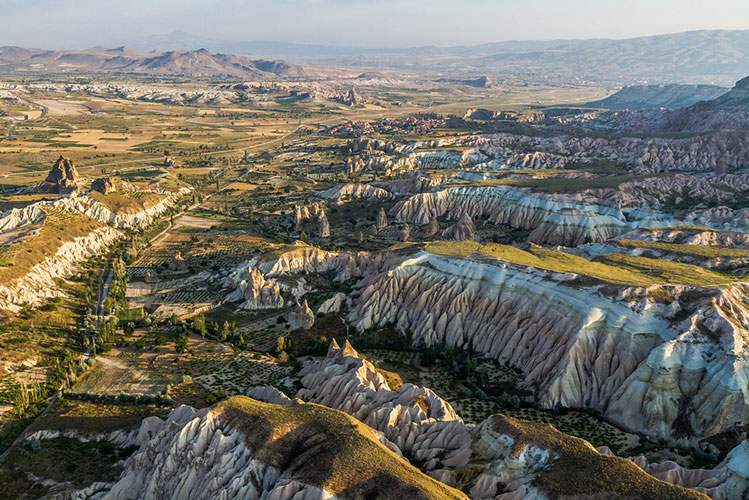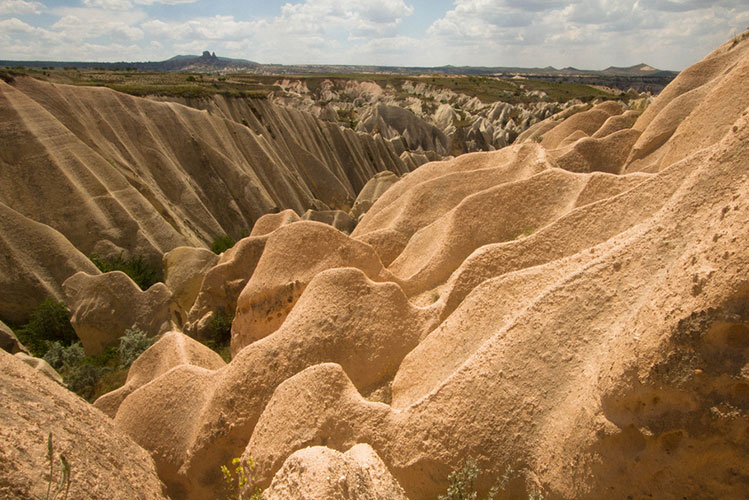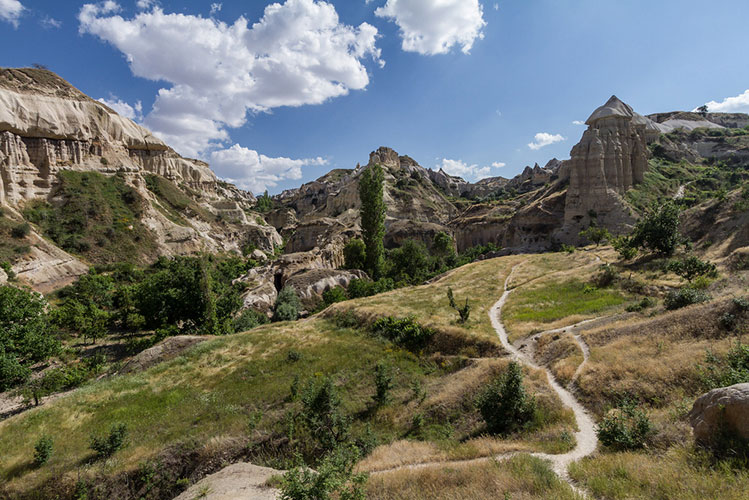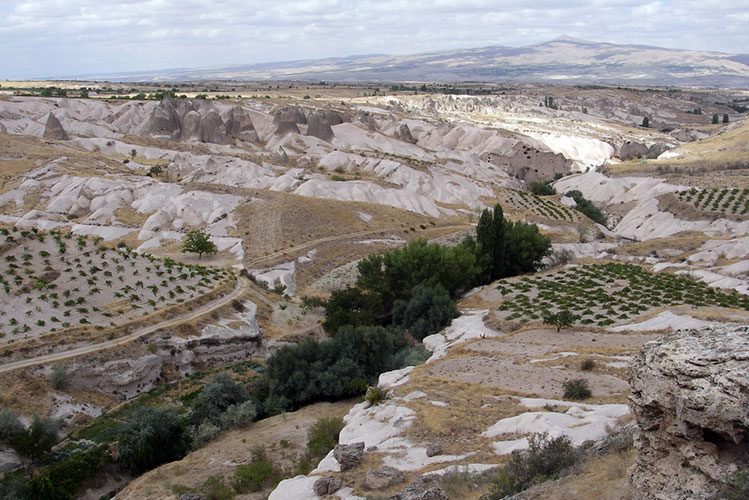Ballooning companies such as Butterfly Balloons and Royal Balloon can get you floating high above the sinewy valleys for a visual lesson in the slow process of erosion that has moulded this region of Turkey. But Cappadocia's undulating topography is even better appreciated close up.
Walking within the furrows of the valleys is like strolling amid a storybook land. The region's conical rock formations, known locally as 'fairy chimneys', could have been plucked straight out of a child's imagination. Just as amazing as these moonscape sweeps of natural scenery is the human history that can be explored here.

Aerial view of Cappadocia by Benh Lieu Song. CC BY-SA 2.0.
Making Swiss cheese out of the surrounding cliff faces, the pigeon house architecture of Cappadocia's valleys is a vestige of the area's agricultural heritage. Delve a little further and secreted within the narrow gullies and dug out of the tor slopes of soft volcanic rock are the cave churches and hermitages used by the religious communities who made their home here during the Byzantine era.
Reputable local tour agencies Middle Earth Travel and Heritage Travel both run walking-focused tours with experienced guides whose knowledge of the region will enhance any hike. Most of the trails can also be tackled independently.
Whichever way you choose to explore, when you land back on earth after your hot air balloon ride, it's time to pull on your hiking boots and stride into the valleys themselves. To sample a great cross-section of both cultural history and natural wonder, here are three of the best valleys for walkers.

Rose Valley by Helen Cook. CC BY-SA 2.0
Stretching between the villages of Göreme and Çavuşin, the interlinking Rose (Güllüdere) and Red (Kızılçukur) Valleys are two of Cappadocia's most interesting and the easiest to access. Trails lead across surreally-shaped ridges, through water-sculpted tunnels, and dive down into narrow basins hosting rock-cut churches (kilise in Turkish) surrounded by orchards and farm plots. There are plenty of signposts allowing easy navigation and walkers can choose everything from a one-hour stroll to an all-day hike.
For the best combination of history and rock panoramas, hike first to Kolonlu Kilise, with its grand columned nave hidden within a sheer rock face. Then head up on to the ridge which holds the Haçlı Kilise, with its still vibrant apse fresco and huge carved ceiling cross. Afterwards, follow the trail as it leads across the high ridge, with its views across the surging curls of rock, down to the Üç Haçlı Kilise, which has an ornately carved ceiling and interesting fresco remnants.
To get here: there are several trailheads into the valleys from the northern outskirts of Göreme and past the cemetery in Çavuşin.

Pigeon Valley by Benh Lieu Song. CC BY-SA 2.0
Straddled on both sides by cliff faces, this narrow valley follows a meandering stream along a trail enclosed by poplar trees and rambling brambles. Only a handful of hikers walk Zemi each day, making it a top pick for those who want a quiet path still within easy ambling distance from the main tourist villages.
This walk is superb for nature lovers: you'll encounter plenty of birdlife flitting through the trees, frogs frolicking in the stream and the odd tortoise soaking up the heat on a sunny rock if you keep your eyes peeled. For history fans, both the 10th-century El Nazar Kilise, carved out of a standalone protruding cone, and 11th-century Saklı Kilise can be visited on paths that branch off the main route near the Göreme trailhead.
To get here: for an uphill hike, choose the trailhead just outside of Göreme on the road to Göreme Open-Air Museum. For downhill all the way, the trailhead is on the main highway, just south of Uçhisar. Many hotel owners in Göreme are happy to drop guests off at the Uçhisar trailhead.

Çat Valley by Jean and Nathalie. CC BY 2.0.
Çat Valley missed the region's tourism boom in a big way. Hikers walking through this wide valley, hemmed in by high-rise cliffs, rarely see anyone except the odd farmer grazing his cows. The visitors may be missing but this valley is home to some of Cappadocia's best pigeon-house art. The cotes pockmark the cliff faces here. Their slim entrances, chiselled into the rock high above, are bordered by decorations of simple scrolling patterns, 'tree of life' motifs and whimsical daisy chains. Hikers follow the valley until it opens out into a field of poplar trees and then ends at the ruins of Açıksaray; a 9th-century group of churches.
To get here: despite being a little off the beaten trail, Çat Valley is easy to access via public transport from the regional hub of Nevşehir. All the popular Cappadocian villages have regular (hourly or half hourly) dolmuş (local bus) transport to Nevşehir; from there you'll find hourly dolmuşes to Çat village. The trailhead to the valley is signposted from the centre of the village. If you don't want to retrace your way back to the village afterwards you can walk out to the highway from Açıksaray and hail down a dolmuş to Nevşehir there.
Most hotel owners in Cappadocia's villages are pretty clued up on the various hikes that can be done in the area, but some are better than others. If you don't have your own transport, the village of Göreme is the best situated, snuggled right amid the region's best walking valleys.
At both Taşkonak Hotel and Gedik Cave Hotel in Göreme the owner-operators are enthusiastic hikers who can provide guests with bucketloads of local walking knowledge. In nearby Uçhisar both Takaev and Kilim Pension have owners who regularly lead guests through the surrounding valleys themselves.